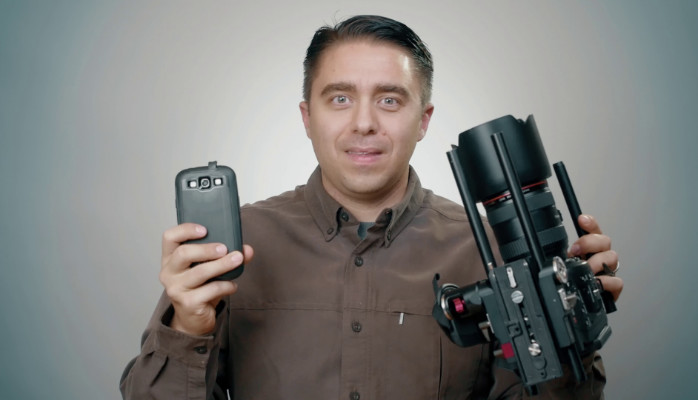
IPhone vs Cinema Camera: Why great gear won’t help you make great videos if you haven’t paid the deductible
“I don’t want to start until I get a better camera.” This is one of the most common concerns I hear when I’m asked to help a friend, colleague or client select video equipment.
Often times, this statement is made by professionals, managers, and executives who realize that they need to start making video content for their stakeholders, employees, or customers, but have never used video to engage and educate an audience.
The larger the budget, the bigger a challenge it can be…
“Anthony, we have a $20k budget to put together a little studio, will that be enough to get us started making engaging videos?” This was the question posed to me by a government colleague who I respect and look up to as a mentor. I want this person to be successful, and I want them to purchase the right equipment, the first time around. My response was: “That amount won’t be close to enough if you don’t pay the deductible first.”
For first-time video makers, guidance and practice is orders of magnitude more important than equipment.
The deductible, in case you are wondering, is understanding that the first videos a novice makes, are going to suck... badly. No amount of gear is going to change this. For some, it is 100 videos, for other, it is 50. There is no way around the deductible when it comes to being comfortable on video… but we can make paying it easier, more productive, and essentially free.
Getting started can bring out strong resistance.
When advising my government colleague, I suggested that she start paying the deductible by delaying her gear purchase and using her smartphone to record video. She was primarily interested in making training and educational videos, so I provided her with a framework that forced her to focus the content of her videos on a single problem that her trainees faced, and then present a single solution to that problem. I have three chapters dedicated to this framework in my workbook, but suffice to say, this method allows for unscripted videos that are focused and keep the attention of an adult learner. (Message me if you’d like more info on this or a link to the pdf.)
Show, Don't Tell: the power of demonstrations and letting your viewer come to their own conclusion.
Second, I wanted to provide an example for her, as demonstrating something is so much more powerful than explaining it. In our discussion, she had expressed her skepticism about the quality of the camera in her smartphone. So I decided that my demonstration would detail a comparison between an iphone and a professional digital cinema camera. When watching this video, pay attention to how the following factors play into the actual quality you perceive in the video.
- The camera sensor itself
- The lighting
- The audio/microphone (the second video is entirely about lighting and sound)
In the end, she made about 15 videos with her smartphone. The videos averaged three minutes each. The most empowering thing for her was seeing the difference between the first video and the last. We went through my workbook together, and in addition to eliminating most “Ums, and uhs” she really just felt more confident on camera.
The second video is an in-depth overview of how lighting and audio quality impacts the video.
The most important thing from my perspective was that she saw for herself that the gear she wanted to buy originally, would not have served her needs. In the end she was not only confident on camera, but was confident in selecting the gear that would help in conveying her message. I encourage friends and colleagues to get started paying the deductible before making major gear purchases. So... What message would you like to start conveying to your audience?
In case you are wondering, yes, the cinema camera ultimately wins in terms of features vs the smartphone. The thing is that most of those features are focused on workflow, efficiency, and interoperability with other pro video gear. all things that were not necessarily important to the gov't exec I mentioned here.
To learn more about getting started with video in your gederal government organization? Visit https://GovernmentVideoGuide.com
Content Marketer
7yBTW, my camera package was the Canon XL-1 with multiple lenses and an Arri 4 head light kit. Compact, one man band! Edited/compressed on a Dell Dual Core with Premier/After FX/Photoshop. Scored my own videos with Sonic Foundry. Concept to completion!
Content Marketer
7yThe old adage "the right tool for the job" rings true for this post. The more you use a tool the more proficient you will be and you can work your way up to pro results. Now, about that editing software....
Physical Therapist at Linn Benton Lincoln ESD
7yVery tangible advice.
Guiding students toward academic success
7yWell done.